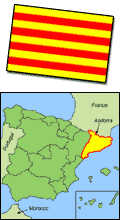 |
 Barcelona
- City Districts Barcelona
- City Districts
To get a general idea of the layout of
Barcelona one has to look at a map of the city. The centre
shows a large square area which corresponds to the city's
growth between 1860 and 1936 approximately. This area is known as "Eixample" or "Ensanche" (Extension)
and stretches as far as Tarragona street to the left, Avinguda Josep Tarradellas
and Avinguda Diagonal at the top, the Passeig de Sant Joan to the right, and
the Gran Via de les Corts Catalanes and Rondes de la Universitat and Sant Pere
at the bottom. The part of El Ensanche to the left of Balmes street is known
as Izquierda del Ensanche, and the part to the right as Derecha del Ensanche.
This is by far the most interesting part, for it is here that we find the Rambla
de Catalunya and Passeig de Gracia, as well as a large amount of Modernist
buildings, shops, offices of important companies and banks.
Between El Ensanche and the port area there is an area of narrow, irregularly
laid out streets. This is Old Barcelona and takes the shape of a six sided
polygon formed by the Avinguda del Parallel, the Rondes of Sant Pau, Sant Antoni,
la Universitat and Sant Pere, the Passeig Picasso and, by the sea, the Passeig
de Colom. Old Barcelona is also divided into three parts: firstly what is known
as the district of La Antigua, between La Rambla and La Via Laietana; to the
left of this is the district of El Raval and finally, to the right stands the
Ribera district. Of the three, perhaps the most interesting is the the district
of La Antigua. There is an almost oval-shaped area contained within this district
which is bounded by the streets of Avinyó, Banys Nous, la Palla, the
Avinguda de la Catedral, the Via Laietana and Carrer Ample. This is the oldest
and most typically Spanish quarter in Barcelona and is known as the "Barrio
Gotico" (Gothic quarter) because of the great many Gothic buildings it
contains. La Rambla, on the other hand, is the most famous and typical street
in Barcelona, and therefore one of the places that is most frequented by visitors.
To the left of the area of Old Barcelona stands the hill of Montjuic. This
is of particular interest because of its museums, sports and exhibition complexes
and other forms of entertainment. To the right of this area stands the Ciutadella
Park where we can find a variety of installations, including the Catalunyan
Parliament, the Museum of Modern Art and the Zoo. Between this park and the
port stands the triangular-shaped maritime district of La Barceloneta. This
very typical district juts out into the sea.
The city's upper districts, from the Avinguda Diagonal towards the left, are
also the most salubrious, and so it is not surprising that they are also the
most aristocratic. This is especially so in the case of the district of Pedralbes,
with its sports complexes and university campus, and, to a lesser extent, the
districts of Sarria and La Bonanova. Above these, in the Sierra de Collserola,
we find the villages and mountainous areas of Vallvidrera, Le Floresta, Les
Planes and Valldoreix. In the central area, between the Avinguda Diagonal and
the foot of Mount Tibidabo around the streets of Aribau and Muntaner, we find
the district of Sant Gervasi. To the right of this is located the old town
of Gracia above the Avinguda Diagonal, with its small squares and craftsmen's
workshops.
The area furthest to the left, on the far side of the hill of Montjuic, is
known as the Zona Franca, and above this there is the town of l´Hospitalet
(There is no difference between this and the adjoining area to Barcelona) and
between this and El Ensanche, below the Avinguda diagonal, the town-cum-districts
of Les Corts and Sants.
The right-hand areas of Barcelona contain, amongst others the districts of
El Guinardó and Horta. Even further to the right are the more popular
districts, which, for the most part, were formed after 1940 by immigrants.
These include Sant Andreu de Palomar, Sant Adria de Besos and Nou Barris. The
district nearest the sea is known as Poble Nou.
To sum up, there is El Ensanche in the centre; Montjuic, Old Barcelona and
la Barceloneta beside the sea; the aristocratic districts on the left-hand
side between Mount Tibidabo and the Avinguda Diagonal; the former town of Gracia
in the centre and the popular districts to the right. This, of course, is a
very simplified summary but it is enough to give one some idea of the layout
of the city.
 |

See
what tours we have available here! |
Book Organized Tours of Spain
Popular tours sell out well in advance! Don't be
disappointed!
Reduce stress! Don't waste time haggling with the hotel concierge.
Lock in your price! Currency dips & price hikes won't effect you.
Save vacation time! Plan & book now, not when you're there.
Balance your vacation budget! Charge tours on this month's credit card bill. |
|

See
what tours we have available here! |
 |
Related sites
Cellar
Tours - Gourmet wine tours in Spain and Portugal. Includes tours of Penedes
and Tarragona in Catalonia
|
 |




